雅思阅读真题题型汇总表
- 格式:xls
- 大小:59.00 KB
- 文档页数:14
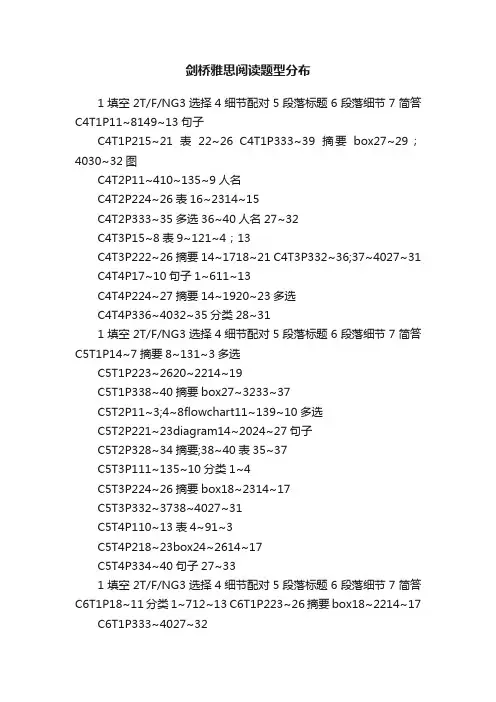
剑桥雅思阅读题型分布1填空2T/F/NG3选择4细节配对5段落标题6段落细节7简答C4T1P11~8149~13句子C4T1P215~21表22~26 C4T1P333~39摘要box27~29;4030~32图C4T2P11~410~135~9人名C4T2P224~26表16~2314~15C4T2P333~35多选36~40人名27~32C4T3P15~8表9~121~4;13C4T3P222~26摘要14~1718~21 C4T3P332~36;37~4027~31 C4T4P17~10句子1~611~13C4T4P224~27摘要14~1920~23多选C4T4P336~4032~35分类28~311填空2T/F/NG3选择4细节配对5段落标题6段落细节7简答C5T1P14~7摘要8~131~3多选C5T1P223~2620~2214~19C5T1P338~40摘要box27~3233~37C5T2P11~3;4~8flowchart11~139~10多选C5T2P221~23diagram14~2024~27句子C5T2P328~34摘要;38~40表35~37C5T3P111~135~10分类1~4C5T3P224~26摘要box18~2314~17C5T3P332~3738~4027~31C5T4P110~13表4~91~3C5T4P218~23box24~2614~17C5T4P334~40句子27~331填空2T/F/NG3选择4细节配对5段落标题6段落细节7简答C6T1P18~11分类1~712~13 C6T1P223~26摘要box18~2214~17 C6T1P333~4027~32C6T2P16~1011~13地点1~5C6T2P214~22box23~26句子C6T2P332~4027~31句子C6T3P16~910~131~5C6T3P219~2425~27人名14~18C6T3P338~40flowchart28~3233~37分类C6T4P18~131~7C6T4P214~18摘要box19~2425~26多选C6T4P335~39摘要31~34;4027~301填空2T/F/NG3选择4细节配对5段落标题6段落细节7简答C7T1P16~9摘要;10~13句子1~5C7T1P221~2614~20C7T1P337~40box31~3627~30C7T2P11~411~135~10分类C7T2P222~26摘要18~2114~17C7T2P331~354036~39句子27~30C7T3P17~13box1~6C7T3P220~21表2622~25分类14~19C7T3P327~334034~39句子C7T4P18~13摘要1~7C7T4P214~2021~26C7T4P330~34box27~2935~40人名1填空2T/F/NG3选择4细节配对5段落标题6段落细节7简答C8T1P19~13diagram5~8地点1~4C8T1P220~2614~19C8T1P331~40表27~30句子C8T2P11~8表+flowchart9~13C8T2P218~22摘要box23~26分类14~17C8T2P337~40句子33~3627~32C8T3P14~6句子;7~10box11~131~3C8T3P219~2614~18多选C8T3P333~36句子37~4027~32C8T4P16~910~131~5C8T4P218~2114~1722~26句子C8T4P337~40diagram27~3031~36分类。
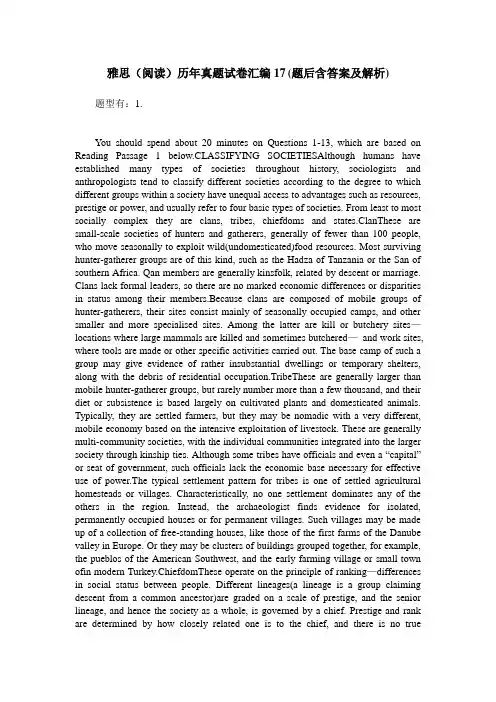
雅思(阅读)历年真题试卷汇编17(题后含答案及解析) 题型有:1.You should spend about 20 minutes on Questions 1-13, which are based on Reading Passage 1 below.CLASSIFYING SOCIETIESAlthough humans have established many types of societies throughout history, sociologists and anthropologists tend to classify different societies according to the degree to which different groups within a society have unequal access to advantages such as resources, prestige or power, and usually refer to four basic types of societies. From least to most socially complex they are clans, tribes, chiefdoms and states.ClanThese are small-scale societies of hunters and gatherers, generally of fewer than 100 people, who move seasonally to exploit wild(undomesticated)food resources. Most surviving hunter-gatherer groups are of this kind, such as the Hadza of Tanzania or the San of southern Africa. Qan members are generally kinsfolk, related by descent or marriage. Clans lack formal leaders, so there are no marked economic differences or disparities in status among their members.Because clans are composed of mobile groups of hunter-gatherers, their sites consist mainly of seasonally occupied camps, and other smaller and more specialised sites. Among the latter are kill or butchery sites—locations where large mammals are killed and sometimes butchered—and work sites, where tools are made or other specific activities carried out. The base camp of such a group may give evidence of rather insubstantial dwellings or temporary shelters, along with the debris of residential occupation.TribeThese are generally larger than mobile hunter-gatherer groups, but rarely number more than a few thousand, and their diet or subsistence is based largely on cultivated plants and domesticated animals. Typically, they are settled farmers, but they may be nomadic with a very different, mobile economy based on the intensive exploitation of livestock. These are generally multi-community societies, with the individual communities integrated into the larger society through kinship ties. Although some tribes have officials and even a “capital”or seat of government, such officials lack the economic base necessary for effective use of power.The typical settlement pattern for tribes is one of settled agricultural homesteads or villages. Characteristically, no one settlement dominates any of the others in the region. Instead, the archaeologist finds evidence for isolated, permanently occupied houses or for permanent villages. Such villages may be made up of a collection of free-standing houses, like those of the first farms of the Danube valley in Europe. Or they may be clusters of buildings grouped together, for example, the pueblos of the American Southwest, and the early farming village or small town ofin modern Turkey.ChiefdomThese operate on the principle of ranking—differences in social status between people. Different lineages(a lineage is a group claiming descent from a common ancestor)are graded on a scale of prestige, and the senior lineage, and hence the society as a whole, is governed by a chief. Prestige and rank are determined by how closely related one is to the chief, and there is no truestratification into classes. The role of the chief is crucial.Often, there is local specialisation in craft products, and surpluses of these and of foodstuffs are periodically paid as obligation to the chief. He uses these to maintain his retainers, and may use them for redistribution to his subjects. The chiefdom generally has a center of power, often with temples, residences of the chief and his retainers, and craft specialists. Chiefdoms vary greatly in size, but the range is generally between about 5000 and 20,000 persons.Early StateThese preserve many of the features of chiefdoms, but the ruler(perhaps a king or sometimes a queen)has explicit authority to establish laws and also to enforce them by the use of a standing army. Society no longer depends totally upon kin relationships: it is now stratified into different classes. Agricultural workers and the poorer urban dwellers form the lowest classes, with the craft specialists above, and the priests and kinsfolk of the ruler higher still. The functions of the ruler are often separated from those of the priest: palace is distinguished from temple. The society is viewed as a territory owned by the ruling lineage and populated by tenants who have an obligation to pay taxes. The central capital houses a bureaucratic administration of officials; one of their principal purposes is to collect revenue(often in the form of taxes and tolls)and distribute it to government, army and craft specialists. Many early states developed complex redistribution systems to support these essential services.This rather simple social typology set out by Elman Service and elaborated by William Sanders and Joseph Marino, can be criticised, and it should not be used unthinkingly. Nevertheless, if we are seeking to talk about early societies, we must use words and hence concepts to do so. Service’s categories provide a good framework to help organise our thoughts.Questions 1-7Do the following statements agree with the information given in Reading Passage 1?In boxes 1-7 on your answer sheet, writeTRUE if the statement agrees with the informationFALSE if the statement contradicts the informationNOT GIVEN if there is no information on this1.There’s little economic difference between members of a clan.A.真B.假C.Not Given正确答案:A解析:利用细节信息“clan”和“economic difference”定位于原文Clan部分的第一个分段落的最后一句话“there are no marked economic differences or disparities in status amongtheir members”。
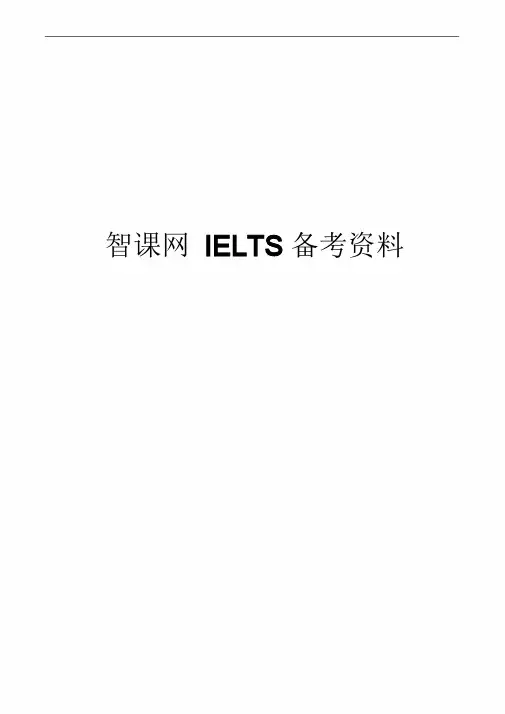
智课网IELTS备考资料雅思阅读真题附答案(完整版)摘要:雅思阅读真题是考生练习雅思阅读的必备资料。
不少考生在网上寻求雅思阅读真题,今天小编汇总了里面雅思阅读真题附答案版,方便考生复习。
雅思阅读真题是历年雅思考试中出现的雅思阅读题目,练习雅思阅读真题对于考生提升雅思阅读答题能力有很大的帮助。
小编整理了历年雅思阅读真题附答案,帮助考生复习雅思阅读。
雅思阅读真题附答案版(部分内容):题型:人名观点配对他在寻找古老的湖泊,这名Mungo 女子是被火葬的 A持怀疑态度的教授对一些化石的DNA 进行了可靠的分析 E教授测定的人的年龄要比62000 年前年轻的多的结果 A确定Mungo 人的年龄,争议了澳大利亚人的起源 B在澳洲,研究小组谁先恢复生物的证据,发现尼安德特人 C年代的支持者认为澳大利亚巨型动物的灭绝是由于古代人类狩猎造成的 D多区域的解释已经被提出,而不是坚持认为单一的起源 B史前人类活动导致气候变化而不是巨型动物的灭绝 A判断题Mungo 湖仍然为考古学家提供了图解说明人类活动的证据True在Mungo 湖发现Mungo 使用的武器Not givenMungo 人是在复杂的文化世界上已知最古老的考古证据之一,如埋葬仪式TrueMungo 男人和女人的骨架是被发现在同一年False澳大利亚教授使用古老的研究方法对“走出非洲”支持者的批判Not given以上就是关于雅思阅读真题附答案的相关汇总,考生可以通过上方下载完整版历年雅思阅读真题解析,提升资深雅思阅读能力。
相关字搜索:雅思阅读真题附答案人生中每一次对自己心灵的释惑,都是一种修行,都是一种成长。
相信我们常常用人生中的一些痛,换得人生的一份成熟与成长然⋯⋯生活里的每个人,都是我们的一面镜子,你给别人什世界上的幸福,没有一处不是来自用心经营和珍惜。
当你一味的去挑剔指责别人的时候,有没有反思过是否?假如你的心太过自我不懂得经营和善待,不懂得尊重他人感受,那你永远也不会获得真和幸福 ⋯ ⋯人生就像一场旅行,我们所行走的每一步都是在丰富生命的意义。
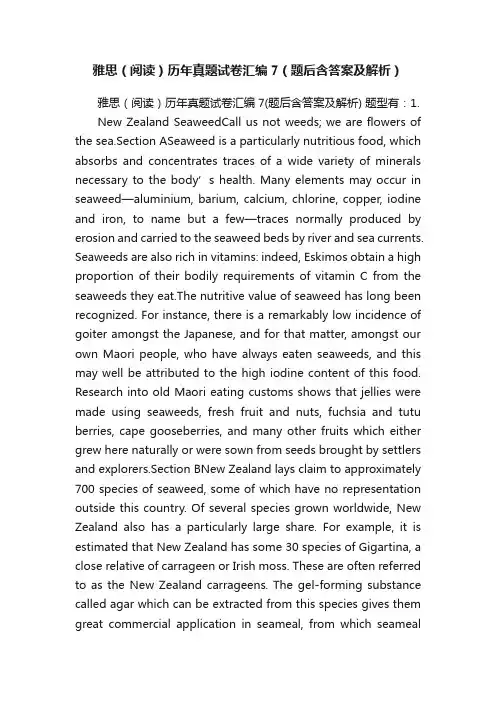
雅思(阅读)历年真题试卷汇编7(题后含答案及解析)雅思(阅读)历年真题试卷汇编7(题后含答案及解析) 题型有:1.New Zealand SeaweedCall us not weeds; we are flowers of the sea.Section ASeaweed is a particularly nutritious food, which absorbs and concentrates traces of a wide variety of minerals necessary to the body’s health. Many elements may occur in seaweed—aluminium, barium, calcium, chlorine, copper, iodine and iron, to name but a few—traces normally produced by erosion and carried to the seaweed beds by river and sea currents. Seaweeds are also rich in vitamins: indeed, Eskimos obtain a high proportion of their bodily requirements of vitamin C from the seaweeds they eat.The nutritive value of seaweed has long been recognized. For instance, there is a remarkably low incidence of goiter amongst the Japanese, and for that matter, amongst our own Maori people, who have always eaten seaweeds, and this may well be attributed to the high iodine content of this food. Research into old Maori eating customs shows that jellies were made using seaweeds, fresh fruit and nuts, fuchsia and tutu berries, cape gooseberries, and many other fruits which either grew here naturally or were sown from seeds brought by settlers and explorers.Section BNew Zealand lays claim to approximately 700 species of seaweed, some of which have no representation outside this country. Of several species grown worldwide, New Zealand also has a particularly large share. For example, it is estimated that New Zealand has some 30 species of Gigartina, a close relative of carrageen or Irish moss. These are often referred to as the New Zealand carrageens. The gel-forming substance called agar which can be extracted from this species gives them great commercial application in seameal, from which seamealcustard is made, and in cough mixtures, confectionery, cosmetics, the canning, paint and leather industries, the manufacture of duplicating pads, and in toothpastes. In fact, during World War II, New Zealand Gigartina were sent to Australia to be used in toothpaste.Section CYet although New Zealand has so much of the commercially profitable red seaweeds, several of which are a source of agar(Pterocladia, Gelidium, Chondrus, Gigartina), before 1940 relatively little use was made of them. New Zealand used to import the Northern Hemisphere Irish moss(Chondrus crispus)from England and ready-made agar from Japan. Although distribution of the Gigartina is confined to certain areas according to species, it is only on the east coast of the North Island that its occurrence is rare. And even then, the east coast, and the area around Hokiangna, have a considerable supply of the two species of Pterocladia from which agar is also available. Happily, New Zealand-made agar is now obtainable in health food shops. Section D Seaweeds are divided into three classes determined by colour—red, brown and green—and each tends to live in a specific location. However, except for the unmistakable sea lettuce(Ulva), few are totally one colour; and especially when dry, some species can change colour quite significantly—a brown one may turn quite black, or a red one appear black, brown, pink or purple. Identification is nevertheless facilitated by the。
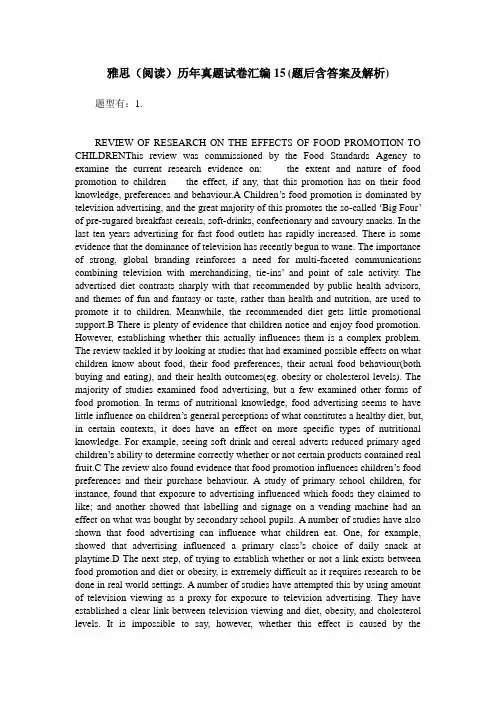
雅思(阅读)历年真题试卷汇编15(题后含答案及解析) 题型有:1.REVIEW OF RESEARCH ON THE EFFECTS OF FOOD PROMOTION TO CHILDRENThis review was commissioned by the Food Standards Agency to examine the current research evidence on: the extent and nature of food promotion to children the effect, if any, that this promotion has on their food knowledge, preferences and behaviour.A Children’s food promotion is dominated by television advertising, and the great majority of this promotes the so-called ‘Big Four’of pre-sugared breakfast cereals, soft-drinks, confectionary and savoury snacks. In the last ten years advertising for fast food outlets has rapidly increased. There is some evidence that the dominance of television has recently begun to wane. The importance of strong, global branding reinforces a need for multi-faceted communications combining television with merchandising, tie-ins’and point of sale activity. The advertised diet contrasts sharply with that recommended by public health advisors, and themes of fun and fantasy or taste, rather than health and nutrition, are used to promote it to children. Meanwhile, the recommended diet gets little promotional support.B There is plenty of evidence that children notice and enjoy food promotion. However, establishing whether this actually influences them is a complex problem. The review tackled it by looking at studies that had examined possible effects on what children know about food, their food preferences, their actual food behaviour(both buying and eating), and their health outcomes(eg. obesity or cholesterol levels). The majority of studies examined food advertising, but a few examined other forms of food promotion. In terms of nutritional knowledge, food advertising seems to have little influence on children’s general perceptions of what constitutes a healthy diet, but, in certain contexts, it does have an effect on more specific types of nutritional knowledge. For example, seeing soft drink and cereal adverts reduced primary aged children’s ability to determine correctly whether or not certain products contained real fruit.C The review also found evidence that food promotion influences children’s food preferences and their purchase behaviour. A study of primary school children, for instance, found that exposure to advertising influenced which foods they claimed to like; and another showed that labelling and signage on a vending machine had an effect on what was bought by secondary school pupils. A number of studies have also shown that food advertising can influence what children eat. One, for example, showed that advertising influenced a primary class’s choice of daily snack at playtime.D The next step, of trying to establish whether or not a link exists between food promotion and diet or obesity, is extremely difficult as it requires research to be done in real world settings. A number of studies have attempted this by using amount of television viewing as a proxy for exposure to television advertising. They have established a clear link between television viewing and diet, obesity, and cholesterol levels. It is impossible to say, however, whether this effect is caused by theadvertising, the sedentary nature of television viewing or snacking that might take place whilst viewing. One study resolved this problem by taking a detailed diary of children’s viewing habits. This showed that the more food adverts they saw, the more snacks and calories they consumed.E Thus the literature does suggest food promotion is influencing children’s diet in a number of ways. This does not amount to proof; as noted above with this kind of research, incontrovertible proof simply isn’t attainable. Nor do all studies point to this conclusion; several have not found an effect. In addition, very few studies have attempted to measure how strong these effects are relative to other factors influencing children’s food choices. Nonetheless, many studies have found clear effects and they have used sophisticated methodologies that make it possible to determine that i)these effects are not just due to chance; ii)they are independent of other factors that may influence diet, such as parents’ eating habits or attitudes; and iii)they occur at a brand and category level.F Furthermore, two factors suggest that these findings actually downplay the effect that food promotion has on children. First, the literature focuses principally on television advertising; the cumulative effect of this combined with other forms of promotion and marketing is likely to be significantly greater. Second, the studies have looked at direct effects on individual children, and understate indirect influences. For example, promotion for fast food outlets may not only influence the child, but also encourage parents to take them for meals and reinforce the idea that this is a normal and desirable behaviour.G This does not amount to proof of an effect, but in our view does provide sufficient evidence to conclude that an effect exists. The debate should now shift to what action is needed, and specifically to how the power of commercial marketing can be used to bring about improvements in young people’s eating.You should spend about 20 minutes on Questions 1-13, which are based on Reading Passage 1 on the following pages.Questions 1-7Reading Passage 1 has seven paragraphs, A-G.Choose the most suitable heading for paragraphs A-G from the list of headings below.Write the appropriate number, i-x, in boxes 1-7 on your answer sheet.List of Headingsi General points of agreements and disagreements of researchersii How much children really know about foodiii Need to take actioniv Advertising effects of the “Big Four”v Connection of advertising and children’s weight problemsvi Evidence that advertising affects what children buy to eatvii How parents influence children’s eating habitsviii Advertising’s focus on unhealthy optionsix Children often buy what they wantx Underestimating the effects advertising has on children1.Paragraph A正确答案:viii解析:作为开头段落,该段落前半部分先介绍了常见的面向儿童的广告内容,例如“Big Four”,而且介绍了食品促销的现状。
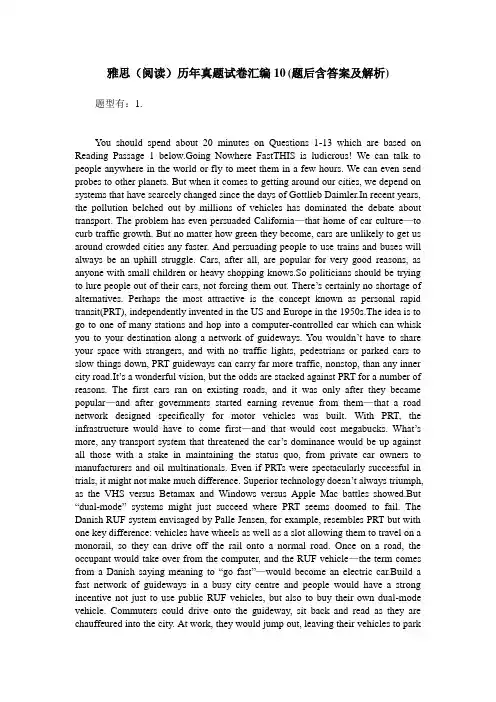
雅思(阅读)历年真题试卷汇编10(题后含答案及解析) 题型有:1.You should spend about 20 minutes on Questions 1-13 which are based on Reading Passage 1 below.Going Nowhere FastTHIS is ludicrous! We can talk to people anywhere in the world or fly to meet them in a few hours. We can even send probes to other planets. But when it comes to getting around our cities, we depend on systems that have scarcely changed since the days of Gottlieb Daimler.In recent years, the pollution belched out by millions of vehicles has dominated the debate about transport. The problem has even persuaded California—that home of car culture—to curb traffic growth. But no matter how green they become, cars are unlikely to get us around crowded cities any faster. And persuading people to use trains and buses will always be an uphill struggle. Cars, after all, are popular for very good reasons, as anyone with small children or heavy shopping knows.So politicians should be trying to lure people out of their cars, not forcing them out. There’s certainly no shortage of alternatives. Perhaps the most attractive is the concept known as personal rapid transit(PRT), independently invented in the US and Europe in the 1950s.The idea is to go to one of many stations and hop into a computer-controlled car which can whisk you to your destination along a network of guideways. You wouldn’t have to share your space with strangers, and with no traffic lights, pedestrians or parked cars to slow things down, PRT guideways can carry far more traffic, nonstop, than any inner city road.It’s a wonderful vision, but the odds are stacked against PRT for a number of reasons. The first cars ran on existing roads, and it was only after they became popular—and after governments started earning revenue from them—that a road network designed specifically for motor vehicles was built. With PRT, the infrastructure would have to come first—and that would cost megabucks. What’s more, any transport system that threatened the car’s dominance would be up against all those with a stake in maintaining the status quo, from private car owners to manufacturers and oil multinationals. Even if PRTs were spectacularly successful in trials, it might not make much difference. Superior technology doesn’t always triumph, as the VHS versus Betamax and Windows versus Apple Mac battles showed.But “dual-mode”systems might just succeed where PRT seems doomed to fail. The Danish RUF system envisaged by Palle Jensen, for example, resembles PRT but with one key difference: vehicles have wheels as well as a slot allowing them to travel on a monorail, so they can drive off the rail onto a normal road. Once on a road, the occupant would take over from the computer, and the RUF vehicle—the term comes from a Danish saying meaning to “go fast”—would become an electric car.Build a fast network of guideways in a busy city centre and people would have a strong incentive not just to use public RUF vehicles, but also to buy their own dual-mode vehicle. Commuters could drive onto the guideway, sit back and read as they are chauffeured into the city. At work, they would jump out, leaving their vehicles to parkthemselves. Unlike PRT, such a system could grow organically, as each network would serve a large area around it and people nearby could buy into it. And a dual-mode system might even win the support of car manufacturers, who could easily switch to producing dual-mode vehicles.Of course, creating a new transport system will not be cheap or easy. But unlike adding a dedicated bus lane here or extending the underground railway there, an innovative system such as Jensen’s could transform cities.And it’s not just a matter of saving a few minutes a day. According to the Red Cross, more than 30 million people have died in road accidents in the past century—three times the number killed in the First World War—and the annual death toll is rising. And what’s more, the Red Cross believes road accidents will become the third biggest cause of death and disability by 2020, ahead of diseases such as AIDS and tuberculosis. Surely we can find a better way to get around?Questions 1-6Do the following statements agree with the information given in Reading Passage 1? In boxes 1-6 on your answer sheet, writeTRUE if the statement agrees with the informationFALSE if the statement contradicts the informationNOT GIVEN if there is no information on this1.City transport developed slower than other means of communication.A.真B.假C.Not Given正确答案:A解析:利用顺序性原则很容易定位到原文开头第一段。
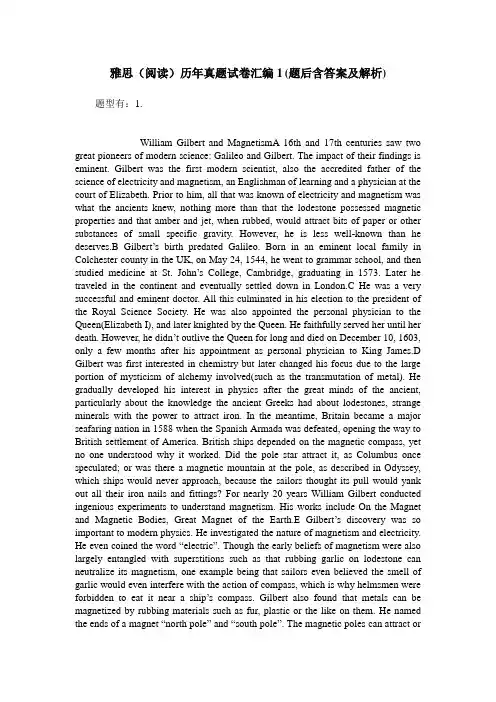
雅思(阅读)历年真题试卷汇编1(题后含答案及解析) 题型有:1.William Gilbert and MagnetismA 16th and 17th centuries saw two great pioneers of modern science: Galileo and Gilbert. The impact of their findings is eminent. Gilbert was the first modern scientist, also the accredited father of the science of electricity and magnetism, an Englishman of learning and a physician at the court of Elizabeth. Prior to him, all that was known of electricity and magnetism was what the ancients knew, nothing more than that the lodestone possessed magnetic properties and that amber and jet, when rubbed, would attract bits of paper or other substances of small specific gravity. However, he is less well-known than he deserves.B Gilbert’s birth predated Galileo. Born in an eminent local family in Colchester county in the UK, on May 24, 1544, he went to grammar school, and then studied medicine at St. John’s College, Cambridge, graduating in 1573. Later he traveled in the continent and eventually settled down in London.C He was a very successful and eminent doctor. All this culminated in his election to the president of the Royal Science Society. He was also appointed the personal physician to the Queen(Elizabeth I), and later knighted by the Queen. He faithfully served her until her death. However, he didn’t outlive the Queen for long and died on December 10, 1603, only a few months after his appointment as personal physician to King James.D Gilbert was first interested in chemistry but later changed his focus due to the large portion of mysticism of alchemy involved(such as the transmutation of metal). He gradually developed his interest in physics after the great minds of the ancient, particularly about the knowledge the ancient Greeks had about lodestones, strange minerals with the power to attract iron. In the meantime, Britain became a major seafaring nation in 1588 when the Spanish Armada was defeated, opening the way to British settlement of America. British ships depended on the magnetic compass, yet no one understood why it worked. Did the pole star attract it, as Columbus once speculated; or was there a magnetic mountain at the pole, as described in Odyssey, which ships would never approach, because the sailors thought its pull would yank out all their iron nails and fittings? For nearly 20 years William Gilbert conducted ingenious experiments to understand magnetism. His works include On the Magnet and Magnetic Bodies, Great Magnet of the Earth.E Gilbert’s discovery was so important to modern physics. He investigated the nature of magnetism and electricity. He even coined the word “electric”. Though the early beliefs of magnetism were also largely entangled with superstitions such as that rubbing garlic on lodestone can neutralize its magnetism, one example being that sailors even believed the smell of garlic would even interfere with the action of compass, which is why helmsmen were forbidden to eat it near a ship’s compass. Gilbert also found that metals can be magnetized by rubbing materials such as fur, plastic or the like on them. He named the ends of a magnet “north pole” and “south pole”. The magnetic poles can attract orrepel, depending on polarity. In addition, however, ordinary iron is always attracted to a magnet. Though he started to study the relationship between magnetism and electricity, sadly he didn’t complete it. His research of static electricity using amber and jet only demonstrated that objects with electrical charges can work like magnets attracting small pieces of paper and stuff. It is a French guy named du Fay that discovered that there are actually two electrical charges, positive and negative.F He also questioned the traditional astronomical beliefs. Though a Coper-nican, he didn’t express in his quintessential beliefs whether the earth is at the center of the universe or in orbit around the sun. However he believed that stars are not equidistant from the earth, but have their own earth-like planets orbiting around them. The earth is itself like a giant magnet, which is also why compasses always point north. They spin on an axis that is aligned with the earth’s polarity. He even likened the polarity of the magnet to the polarity of the earth and built an entire magnetic philosophy on this analogy. In his explanation, magnetism was the soul of the earth. Thus a perfectly spherical lodestone, when aligned with the earth’s poles, would wobble all by itself in 24 hours. Further, he also believed that suns and other stars wobble just like the earth does around a crystal core, and speculated that the moon might also be a magnet caused to orbit by its magnetic attraction to the earth. This was perhaps the first proposal that a force might cause a heavenly orbit.G His research method was revolutionary in that he used experiments rather than pure logic and reasoning like the ancient Greek philosophers did. It was a new attitude toward scientific investigation. Until then, scientific experiments were not in fashion. It was because of this scientific attitude, together with his contribution to our knowledge of magnetism, that a unit of magneto motive force, also known as magnetic potential, was named Gilbert in his honor. His approach of careful observation and experimentation rather than the authoritative opinion or deductive philosophy of others had laid the very foundation for modern science.Reading passage 1 has seven paragraphs A-GChoose the correct heading for each paragraph from the list of headings below.Write the correct number i-x in boxes 1-7 on your answer sheet. List of Headingsi Early years of Gilbertii What was new about his scientific research methodiii The development of chemistryiv Questioning traditional astronomyv Pioneers of the early sciencevi Professional and social recognitionvii Becoming the president of the Royal Science Societyviii The great works of Gilbertix His discovery about magnetismx His change of focus1.Paragraph A正确答案:V解析:段落开头提到具体时间“16th,17th centuries”,同时出现人名Galileo 和Gilbert,与标题v的“early”和“pioneers”对应,段落主体部分讲述这两个人都是伟大的科学家,且对Gilbert进行了更详细的介绍。
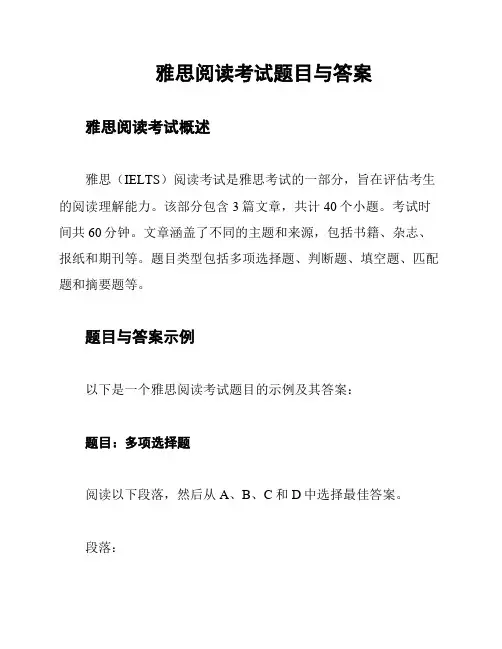
雅思阅读考试题目与答案雅思阅读考试概述雅思(IELTS)阅读考试是雅思考试的一部分,旨在评估考生的阅读理解能力。
该部分包含3篇文章,共计40个小题。
考试时间共60分钟。
文章涵盖了不同的主题和来源,包括书籍、杂志、报纸和期刊等。
题目类型包括多项选择题、判断题、填空题、匹配题和摘要题等。
题目与答案示例以下是一个雅思阅读考试题目的示例及其答案:题目:多项选择题阅读以下段落,然后从A、B、C和D中选择最佳答案。
段落:问题:1. Which of the following statements is TRUE according to the passage?A. The Internet has no impact on our daily life.B. The Internet is crucial to modern life.C. The Internet is a recent invention.答案:1. B. The Internet is crucial to modern life.题目:判断题阅读以下段落,然后判断下列陈述是否正确。
段落:问题:答案:2. False题目:填空题阅读以下段落,然后在空白处填写合适的单词或短语。
段落:"The rise of social media has changed the way we receive news and information. Platforms such as Facebook and Twitter allow users to stay updated on current events in real-time, but they also contribute to the spread of fake news and misinformation."问题:3. The blank in the sentence "The rise of social media has changed the way we _____ and information." should be filled with "_____".答案:3. receive; news题目:匹配题阅读以下段落和列表,然后将列表中的句子与段落中的适当部分进行匹配。
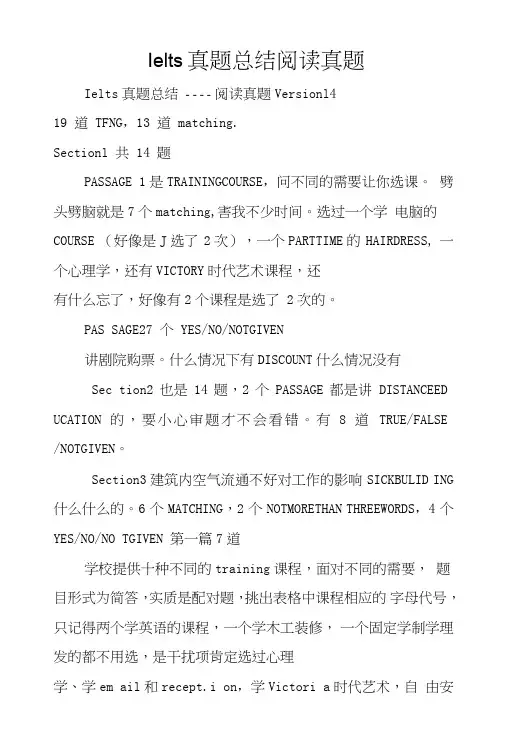
Ielts真题总结阅读真题Ielts真题总结 ---- 阅读真题Versionl419 道TFNG,13 道matching.Sectionl 共14 题PASSAGE 1是TRAININGCOURSE,问不同的需要让你选课。
劈头劈脑就是7个matching,害我不少时间。
选过一个学电脑的COURSE (好像是J选了2次),一个PARTTIME的HAIRDRESS, 一个心理学,还有VICTORY时代艺术课程,还有什么忘了,好像有2个课程是选了2次的。
PAS SAGE27 个YES/NO/NOTGIVEN讲剧院购票。
什么情况下有DISCOUNT什么情况没有Sec tion2也是14题,2个PASSAGE都是讲DISTANCEED UCATION的,要小心审题才不会看错。
有8道TRUE/FALSE /NOTGIVEN。
Section3建筑内空气流通不好对工作的影响SICKBULID ING 什么什么的。
6 个MATCHING,2 个NOTMORETHAN THREEWORDS,4 个YES/NO/NO TGIVEN 第一篇7道学校提供十种不同的training课程,面对不同的需要,题目形式为简答,实质是配对题,挑出表格中课程相应的字母代号,只记得两个学英语的课程,一个学木工装修,一个固定学制学理发的都不用选,是干扰项肯定选过心理学、学em ail和recept.i on,学Victori a时代艺术,自由安排时间兼职学习理发的这几项而且前两个复选,用了两次。
其他记不清了,这点提示应该足够了。
第一扁7个yesnono tgiven我最后好象选成了3yes2false2notgiven观察发现有人误写为Tr uefalsenotg iven大家注意此问题。
Cambr i dge剧院购票预约问题出过题的点有1、残疾人可否带一个人照顾,两个人同时优惠YES2、团体达到十人购票是否优惠YES3、学生可在开场前提前45分钟购票YES4、老人要求优惠是否需要出示老人证Notg iven5、搞活动可在一个C. Hall之外举行no? ? ?其他忘记了Section2 共14 题两篇文章讲同一学校不同方面问题。
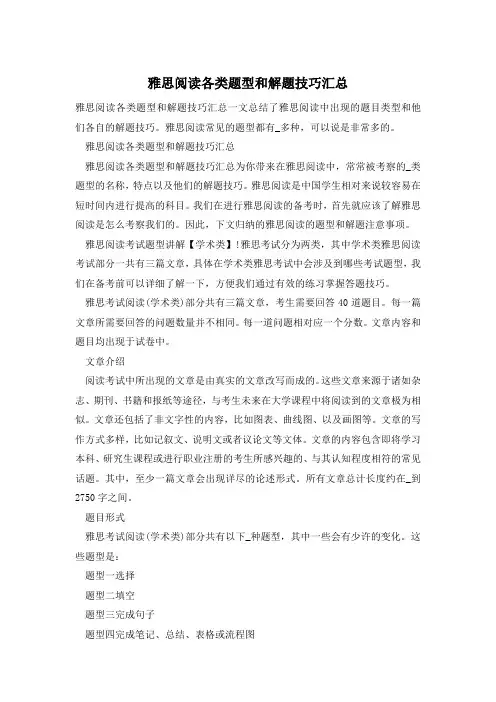
雅思阅读各类题型和解题技巧汇总雅思阅读各类题型和解题技巧汇总一文总结了雅思阅读中出现的题目类型和他们各自的解题技巧。
雅思阅读常见的题型都有_多种,可以说是非常多的。
雅思阅读各类题型和解题技巧汇总雅思阅读各类题型和解题技巧汇总为你带来在雅思阅读中,常常被考察的_类题型的名称,特点以及他们的解题技巧。
雅思阅读是中国学生相对来说较容易在短时间内进行提高的科目。
我们在进行雅思阅读的备考时,首先就应该了解雅思阅读是怎么考察我们的。
因此,下文归纳的雅思阅读的题型和解题注意事项。
雅思阅读考试题型讲解【学术类】!雅思考试分为两类,其中学术类雅思阅读考试部分一共有三篇文章,具体在学术类雅思考试中会涉及到哪些考试题型,我们在备考前可以详细了解一下,方便我们通过有效的练习掌握答题技巧。
雅思考试阅读(学术类)部分共有三篇文章,考生需要回答40道题目。
每一篇文章所需要回答的问题数量并不相同。
每一道问题相对应一个分数。
文章内容和题目均出现于试卷中。
文章介绍阅读考试中所出现的文章是由真实的文章改写而成的。
这些文章来源于诸如杂志、期刊、书籍和报纸等途径,与考生未来在大学课程中将阅读到的文章极为相似。
文章还包括了非文字性的内容,比如图表、曲线图、以及画图等。
文章的写作方式多样,比如记叙文、说明文或者议论文等文体。
文章的内容包含即将学习本科、研究生课程或进行职业注册的考生所感兴趣的、与其认知程度相符的常见话题。
其中,至少一篇文章会出现详尽的论述形式。
所有文章总计长度约在_到2750字之间。
题目形式雅思考试阅读(学术类)部分共有以下_种题型,其中一些会有少许的变化。
这些题型是:题型一选择题型二填空题型三完成句子题型四完成笔记、总结、表格或流程图题型五对图表进行标记题型六为段落或文章的部分选择相对应的小标题题型七寻找信息题型八寻找作者观点、论点或文章中的具体信息题型九分类题型十配对提示:?应仔细阅读题目的指示和说明,这些信息会告诉你在哪里寻找答案、需要如何回答问题、以及答案字数的限定。
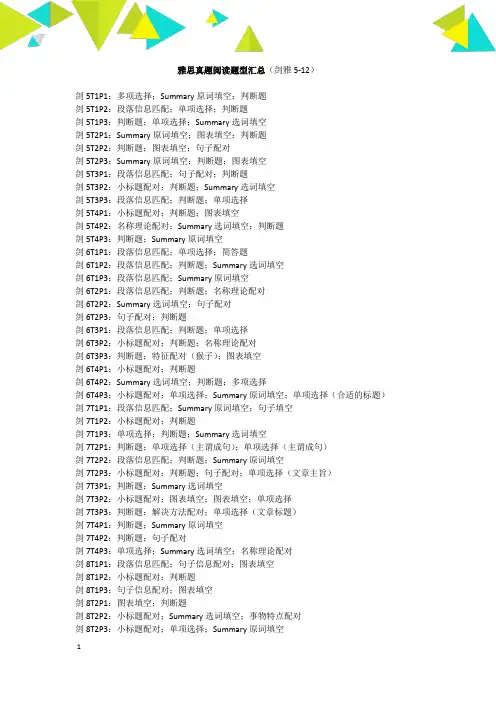
雅思真题阅读题型汇总(剑雅5-12)剑5T1P1:多项选择;Summary原词填空;判断题剑5T1P2:段落信息匹配;单项选择;判断题剑5T1P3:判断题;单项选择;Summary选词填空剑5T2P1:Summary原词填空;图表填空;判断题剑5T2P2:判断题;图表填空;句子配对剑5T2P3:Summary原词填空;判断题;图表填空剑5T3P1:段落信息匹配;句子配对;判断题剑5T3P2:小标题配对;判断题;Summary选词填空剑5T3P3:段落信息匹配;判断题;单项选择剑5T4P1:小标题配对;判断题;图表填空剑5T4P2:名称理论配对;Summary选词填空;判断题剑5T4P3:判断题;Summary原词填空剑6T1P1:段落信息匹配;单项选择;简答题剑6T1P2:段落信息匹配;判断题;Summary选词填空剑6T1P3:段落信息匹配;Summary原词填空剑6T2P1:段落信息匹配;判断题;名称理论配对剑6T2P2:Summary选词填空;句子配对剑6T2P3:句子配对;判断题剑6T3P1:段落信息匹配;判断题;单项选择剑6T3P2:小标题配对;判断题;名称理论配对剑6T3P3:判断题;特征配对(猴子);图表填空剑6T4P1:小标题配对;判断题剑6T4P2:Summary选词填空;判断题;多项选择剑6T4P3:小标题配对;单项选择;Summary原词填空;单项选择(合适的标题)剑7T1P1:段落信息匹配;Summary原词填空;句子填空剑7T1P2:小标题配对;判断题剑7T1P3:单项选择;判断题;Summary选词填空剑7T2P1:判断题;单项选择(主谓成句);单项选择(主谓成句)剑7T2P2:段落信息匹配;判断题;Summary原词填空剑7T2P3:小标题配对;判断题;句子配对;单项选择(文章主旨)剑7T3P1:判断题;Summary选词填空剑7T3P2:小标题配对;图表填空;图表填空;单项选择剑7T3P3:判断题;解决方法配对;单项选择(文章标题)剑7T4P1:判断题;Summary原词填空剑7T4P2:判断题;句子配对剑7T4P3:单项选择;Summary选词填空;名称理论配对剑8T1P1:段落信息匹配;句子信息配对;图表填空剑8T1P2:小标题配对;判断题剑8T1P3:句子信息配对;图表填空剑8T2P1:图表填空;判断题剑8T2P2:小标题配对;Summary选词填空;事物特点配对剑8T2P3:小标题配对;单项选择;Summary原词填空1剑8T3P1:Summary原词填空;Summary选词填空;单项选择剑8T3P2:多项选择;判断题剑8T3P3:小标题配对;Summary原词填空;判断题剑8T4P1:小标题配对;判断题;单项选择剑8T4P2:单项选择;判断题;Summary选词填空剑8T4P3:判断题;事物特点配对;图表填空剑9T1P1:判断题;句子填空剑9T1P2:小标题配对;句子填空;判断题剑9T1P3:句子填空;判断题;表格填空;单项选择剑9T2P1:段落信息匹配;句子填空;多项选择;单项选择剑9T2P2:段落信息匹配;名称理论配对;判断题剑9T2P3:单项选择;判断题;句子配对剑9T3P1:判断题;Summary选词填空;单项选择剑9T3P2:段落信息匹配;多项选择;图表填空剑9T3P3:段落信息匹配;Summary原词填空;判断题剑9T4P1:判断题;Summary原词填空剑9T4P2:段落信息匹配;名称理论配对;Summary原词填空剑9T4P3:小标题配对;单项选择;判断题剑10T1P1:判断题;Summary原词填空;表格填空剑10T1P2:小标题配对;判断题剑10T1P3:单项选择;Summary选词填空;判断题剑10T2P1:小标题配对;判断题剑10T2P2:段落信息匹配;名称理论配对;Summary原词填空剑10T2P3:Summary选词填空;单项选择;判断题剑10T3P1:小标题配对;判断题;Summary原词填空剑10T3P2:段落信息匹配;Summer原词填空;判断题;单项选择(1题)剑10T3P3:Summary选词填空;单项选择(4题);判断题剑10T4P1:表格填空;判断题剑10T4P2:Summer原词填空;名称理论配对;段落信息匹配剑10T4P3:单项选择(5题);句子配对;判断题剑11T1P1:Summary原词填空;判断题剑11T1P2:判断题;图表填空剑11T1P3:段落信息匹配;图表填空;名称理论配对剑11T2P1:判断题;时间事件配对;图表填空剑11T2P2:小标题配对;Summary原词填空;多项选择(1题)剑11T2P3:单项选择(4题);Summary选词填空;判断题;单项选择(1题)剑11T3P1:图表填空;判断题剑11T3P2:判断题;句子配对;Summary原词填空剑11T3P3:段落信息匹配;Summary选词填空剑11T4P1:判断题;句子配对;Summary选词填空剑11T4P2:单项选择(5题);判断题;句子配对剑11T4P3:小标题配对;Summary选词填空;判断题剑12T5P1:判断题;表格填空题剑12T5P2:Summary原词填空;判断题2剑12T5P3:小标题配对;Summary原词填空;判断题剑12T6P1:段落信息匹配;Summary选词填空;多项选择(2题)剑12T6P2:小标题配对;判断题;Summary原词填空剑12T6P3:Summary原词填空;判断题;段落信息匹配剑12T7P1:小标题配对;Summary原词填空剑12T7P2:段落信息匹配;Summary原词填空剑12T7P3:Summary原词填空;单项选择(5题);句子配对剑12T8P1:Summary原词填空;判断题剑12T8P2:单项选择(5题);Summary选词填空;判断题剑12T8P3:小标题配对;判断题;Summary原词填空3。
可编辑修改精选全文完整版雅思阅读题型汇总分类1 Matching题型从属关系搭配或对应2 Summary题型摘要填空3 Short answer questions题型简答题4 Ture/False/Not Given题型是非题6 Headings题型找小标题7 Multiple choice题型选择题8 Sentence completion题型完成句子9 Diagram/flowchart/table completion题型填表填图10 其他题型直接填空、多选多+排序、全文主旨三、09年雅思阅读情况曾经让考生们担心忧虑的2009年雅思考试会不会有变化,以及如何变化,难度又如何,现在已经浮出水面。
通过所经历的这十余次考试我们可以看到,今年的雅思考试延续了2008年的特点,从题型的设置上,到题目的难度上,并没有超出预期。
重点题型依然是由大题型中的搭配题占主导,3月7日的考试中,搭配题就达到了13个,占到了整个题目的32%。
而4 月18日刚刚结束的雅思考试中,搭配题达到了18个,占到了整个题目的45%。
比如,2月 12日的第三篇文章,说的是学校对孩子的影响的研究。
其中出现了四个专家写了四篇论文,标号为paper1,2,3,4 ,要求把其论文和论文的内容相搭配。
又如3月7日的第一篇TORCH RELAY,要求把哪届奥运会和各自火炬搭配在一起。
题型概述及解题思路3 Short answer questions题型简答题1.题型要求每个题目都是一个特殊问句,要求根据原文作出回答。
绝大部分的题目要求有字数限制,一般有如下几种表达方式:(1)NO MORE THAN TWO/THREE/FOUR WORDS(不超过2/3/4个字);(2)ONE OR TWO WORDS(一个或两个字);(3)Use a maximum of TWO words(最多两个字)。
有字数限制的,一定要严格按照题目要求去做。
少部分的题目要求中没有字数限制,这时,请注意,答案字数也不会很长,一般不会超过四个字。
雅思阅读题型分类
雅思阅读题型分类包括:
1.判断题:根据文章内容对所给的描述做出真假判断。
2.多选题:根据文章内容从多个选项中选择所有正确的答案。
3.填空题:根据文章内容填写空缺的单词或短语。
4.匹配题:根据文章内容匹配两列信息,一列为问题另一列为答案。
5.段落标题题:根据文章内容选出最适合每个段落的标题。
6.段落摘要题:根据文章内容选出每个段落的主要意思。
7.选择题:根据文章内容从多个选项中选择一个正确的答案。
8.图表题:根据文章内容分析图表数据并回答问题。
9.短文改错题:根据文章内容找出错误并改正。
A类雅思阅读10大题型分享十面埋伏 A类雅思阅读10大题型之形形色色一、A类雅思阅读考试概括A类雅思考试阅读(学术类)部分共有三篇文章,考生需要回答40道题目。
每一篇文章所需要回答的问题数量并不相同。
每一道问题相对应一个分数。
文章内容和题目均出现于试卷中。
阅读考试中所出现的文章是由真实的文章改写而成的。
这些文章来源于诸如杂志、期刊、书籍和报纸等途径,与考生未来在大学课程中将阅读到的文章极为相似。
文章还包括了非文字性的内容,比如图表、曲线图、以及画图等。
文章的写作方式多样,比如记叙文、说明文或者议论文等文体。
文章的内容包含即将学习本科、研究生课程或进行职业注册的考生所感兴趣的、与其认知程度相符的常见话题。
其中,至少一篇文章会出现详尽的论述形式。
所有文章总计长度约在2000到2750字之间。
二、10大官方题型样式A类雅思考试阅读(学术类)部分共有以下10钟题型,其中一些会有少许的变化。
这些题型是:题型一选择这是一个传统题型,大家都很熟悉。
但就是这种大家都熟悉的题型,IELTS考试也要弄出新花样。
其它考试中,如四级、六级、TOEFL,只有四选一一种形式。
IELTS考试的选择题分为四选一和多选多两种。
题型二填空又叫摘要填空题。
该类题目是一小段文字,是原文或原文中的几个段落主要内容的缩写或改写,我们称之为摘要。
摘要中有几个空白部分要求考生填空。
按照范围,摘要可分为两种:全文摘要和部分段落摘要。
全文摘要,摘要信息来自全文,题目空格的数目较多。
部分段落摘要,摘要信息来自原文某几个连续的段落,题目空格的数目较少。
题型三完成句子每个题目都是一个陈述句,但留有一个或两个空格,要求根据原文填空。
目前考试中,绝大部分都是一个空格,而且在句子的结尾。
例如:THE INTERNATIONAL COMMUNITY HAS BEGUN TO DEMAND…………题型四完成笔记、总结、表格或流程图目中有一个图表或一个表格,其中有一些信息,留出空格,要求根据文章填空。
雅思(阅读)历年真题试卷汇编12(题后含答案及解析) 题型有:1.You should spend about 20 minutes on Questions 1-13 which are based on Reading Passage 1 below.Alfred NobelThe man behind the Nobel PrizeSince 1901, the Nobel Prize has been honoring men and women from all corners of the globe for outstanding achievements in physics, chemistry, medicine, literature, and for work in peace. The foundations for the prize were laid in 1895 when Alfred Nobel wrote his last will, leaving much of his wealth to the establishment of the Nobel Prize.Alfred Nobel was born in Stockholm on October 21,1833. His father Immanuel Nobel was an engineer and inventor who built bridges and buildings in Stockholm. In connection with his construction work Immanuel Nobel also experimented with different techniques for blasting rocks. Successful in his industrial and business ventures, Immanuel Nobel was able, in 1842, to bring his family to St. Petersburg. There, his sons were given a first class education by private teachers. The training included natural sciences, languages and literature. By the age of 17 Alfred Nobel was fluent in Swedish, Russian, French, English and German. His primary interests were in English literature and poetry as well as in chemistry and physics. Alfred’s father, who wanted his sons to join his enterprise as engineers, disliked Alfred’s interest in poetry and found his son rather introverted.In order to widen Alfred’s horizons his father sent him abroad for further training in chemical engineering. During a two year period Alfred Nobel visited Sweden, Germany, France and the United States. In Paris, the city he came to like best, he worked in the private laboratory of Professor T J. Pelouze, a famous chemist. There he met the young Italian chemist Ascanio Sobrero who, three years earlier, had invented nitroglycerine, a highly explosive liquid. But it was considered too dangerous to be of any practical use. Although its explosive power greatly exceeded that of gunpowder, the liquid would explode in a very unpredictable manner if subjected to heat and pressure. Alfred Nobel became very interested in nitroglycerine and how it could be put to practical use in construction work. He also realized that the safety problems had to be solved and a method had to be developed for the controlled detonation of nitroglycerine.After his return to Sweden in 1863, Alfred Nobel concentrated on developing nitroglycerine as an explosive. Several explosions, including one(1864)in which his brother Emil and several other persons were killed, convinced the authorities that nitroglycerine production was exceedingly dangerous. They forbade further experimentation with nitroglycerine within the Stockholm city limits and Alfred Nobel had to move his experimentation to a barge anchored on Lake Malaren. Alfred was not discouraged and in 1864 he was able to start mass production of nitroglycerine. To make the handling of nitroglycerine safer Alfred Nobel experimented with different additives. He soon found that mixing nitroglycerine with kieselguhr would turn the liquid into a paste which could be shaped into rods of a size and form suitable for insertion into drilling holes. In 1867he patented this material under the name of dynamite. To be able to detonate the dynamite rods he also invented a detonator(blasting cap)which could be ignited by lighting a fuse. These inventions were made at the same time as the pneumatic drill came into general use. Together these inventions drastically reduced the cost of blasting rock, drilling tunnels, building canals and many other forms of construction work.The market for dynamite and detonating caps grew very rapidly and Alfred Nobel also proved himself to be a very skillful entrepreneur and businessman. Over the years he founded factories and laboratories in some 90 different places in more than 20 countries. Although he lived in Paris much of his life he was constantly traveling. When he was not traveling or engaging in business activities Nobel himself worked intensively in his various laboratories, first in Stockholm and later in other places. He focused on the development of explosives technology as well as other chemical inventions, including such materials as synthetic rubber and leather, artificial silk, etc. By the time of his death in 1896 he had 355 patents.Intensive work and travel did not leave much time for a private life. At the age of 43 he was feeling like an old man. At this time he advertised in a newspaper “Wealthy, highly-educated elderly gentle-man seeks lady of mature age, versed in languages, as secretary and supervisor of household.” The most qualified applicant turned out to be an Austrian woman, Countess Bertha Kinsky. After working a very short time for Nobel she decided to return to Austria to marry Count Arthur von Suttner. In spite of this Alfred Nobel and Bertha von Suttner remained friends and kept writing letters to each other for decades. Over the years Bertha von Suttner became increasingly critical of the arms race. She wrote a famous book, Lay Down Your Arms and became a prominent figure in the peace movement. No doubt this influenced Alfred Nobel when he wrote his final will which was to include a Prize for persons or organizations who promoted peace. Several years after the death of Alfred Nobel, the Norwegian Storting(Parliament)decided to award the 1905 Nobel Peace Prize to Bertha von Suttner.Alfred Nobel died in San Remo, Italy, on December 10, 1896. When his will was opened it came as a surprise that his fortune was to be used for Prizes in Physics, Chemistry, Physiology or Medicine, Literature and Peace. The executors of his will were two young engineers, Ragnar Sohlman and Rudolf Lilljequist. They set about forming the Nobel Foundation as an organization to take care of the financial assets left by Nobel for this purpose and to coordinate the work of the Prize-Awarding Institutions. This was not without its difficulties since the will was contested by relatives and questioned by authorities in various countries.Alfred Nobel’s greatness lay in his ability to combine the penetrating mind of the scientist and inventor with the forward-looking dynamism of the industrialist. Nobel was very interested in social and peace-related issues and held what were considered radical views in his era. He had a great interest in literature and wrote his own poetry and dramatic works. The Nobel Prizes became an extension and a fulfillment of his lifetime interests.Questions 1-6Do the following statements agree with the information given in Reading Passage 1? In boxes 1-6 on your answer sheet, writeTRUE if the statement agrees with the informationFALSE if the statement contradicts the informationNOT GIVEN if there is no information on this1.The first Nobel Prize was awarded in 1895.A.真B.假C.Not Given正确答案:B解析:利用细节信息“1895”和顺序性原则很容易定位到原文第一段。
--------------------------------------------------------------------------------------------------------------------------------------------------------------------------------雅思考试阅读策略雅思阅读测验题基本上有八种类型:配对题(Matching)真假题(True/False)填充题(Gap fill)选择题(Multiple Choice)完成句子题(Sentence Completion)图解标签题(Diagram Labeling)短问答(Short-answer question)图表完成题(Chart/table completion)不同的文章不同的问题需用不同的技巧。
有些文章您应详细阅读某部分的内容,例如回答完成句子题时,有些文章,您应专注寻找某些有用字眼,这方法最适合用在配对题上。
千万不要勉强自己按顺序回答问题,您可选择先回答能令您更了解文章内容的问题,例如填充题,或先回答较容易的问题。
这样能大增应试的信心。
※不要先阅读文章内容在未清楚目的的时候看阅读测验文章的内容是一件浪费时间的事情,阅读测验是分为3部分,很多考生都会用同一个方法处理每一部分,就是先详细看文章内容或快速扫描内容,等对文章有一定了解时才开始看问题,用这个方法的人通常到最后都会发现时间不够用。
因为在他们阅读文章的时候,他们不知道需要注意什么内容和找什么答案。
※先读题目最快找到答案的方法是知道在哪个段落可找到答案。
如您已清楚每一段的内容大意,您能够一接触问题时便知道哪一段最有可能包含答案。
要用最短的时间了解每个段落的意思,您可用以下方法:先看每个段落的第一句,然后看第二句,再看段落的最后一句。
如到这个时候,您还是不清楚这一段意思的话,您便需要全篇都看。